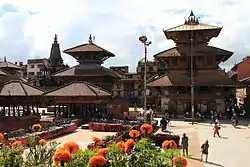Durbar Square
Durbar Square, which means Royal Squares in English, is the generic name used to describe plazas and areas opposite the old royal palaces in Nepal. The name comes from Persian دربار (Darbar). It consists of temples, idols, open courts, water fountains and more. Before the Unification of Nepal, Nepal consisted of small kingdoms, and Durbar Squares are most prominent remnants of those old kingdoms in Nepal. In particular, three Durbar Squares in the Kathmandu Valley, belonging to the three Newar kingdoms situated there before unification, are most famous: Kathmandu Durbar Square, Patan Durbar Square, and Bhaktapur Durbar Square. All three are UNESCO World Heritage Sites.These sites have received significant damage due to the devastating earthquake of 2015 but most structures still remain.

- Durbar Square
 Maju Dega-Narayana-Shiva Parvati
Maju Dega-Narayana-Shiva Parvati Pratapamalla-Jagannath
Pratapamalla-Jagannath Bhimeshwara-Garuda
Bhimeshwara-Garuda Maju Dega-Kamadev
Maju Dega-Kamadev Taleju
Taleju Saraswati-Chyasin Dega
Saraswati-Chyasin Dega
 Souvenirs
Souvenirs Bhagwati Temple (left), Big Bell or Taleju Bell, small Vishnu Temple (right), Kathmandu
Bhagwati Temple (left), Big Bell or Taleju Bell, small Vishnu Temple (right), Kathmandu
See also
- Durbar (court)
- Kathmandu Durbar Square
- Patan Durbar Square
- Bhaktapur Durbar Square
 Media related to Durbar Square at Wikimedia Commons
Media related to Durbar Square at Wikimedia Commons